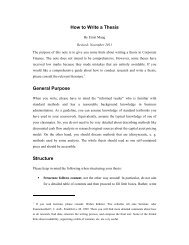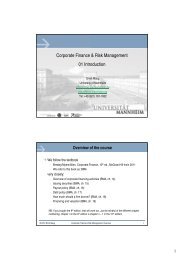Slides. - Maug
Slides. - Maug
Slides. - Maug
You also want an ePaper? Increase the reach of your titles
YUMPU automatically turns print PDFs into web optimized ePapers that Google loves.
Introduction to Financial Databases<br />
Stefan Obernberger<br />
Chair of Corporate Finance, Prof. Ernst <strong>Maug</strong>, PhD
Financial databases at the University of Mannheim (excerpt)<br />
Financial statement data (e.g. balance sheet and income statement information)<br />
US: Compustat North America<br />
Rest of the World: Compustat Global<br />
Europe: AMADEUS (for 10 million listed and non-listed companies in 41 European countries)<br />
Worldwide: Worldscope via Datastream (not available via WRDS)<br />
Stock price and indices data<br />
US: CRSP (Center for Research in Security Prices)<br />
Worldwide: Datastream (not available via WRDS)<br />
SDC Platinum: Worldwide IPOs, SEOs M&As, spin-offs, and repurchases (not available via WRDS)<br />
Capital IQ: Comprehensive & worldwide financial data platform (not available via WRDS)<br />
Compustat Execucomp: US compensation data<br />
Compustat Bank Fundamentals: Accounting data for US banks<br />
I/B/E/S: Worldwide analyst forecast data<br />
Thomson Mutual Funds: Mutual fund data<br />
TAQ: Trades and quotes from US stock markets<br />
3
Important Links<br />
Overview on available financial databases on the homepage of the Chair of Corporate Finance<br />
http://cf.bwl.uni-mannheim.de/data.html<br />
Similar (but better) overview on the library‘s homepage (includes direct access to AMADEUS)<br />
http://www.bib.uni-mannheim.de/1147.html?&L=1<br />
General overview on electronic media<br />
http://www.bib.uni-mannheim.de/132.html?&L=0<br />
4
Access to WRDS, SDC Platinum & Datastream<br />
WRDS - Wharton Research Data Service Information service provider<br />
Gives access to various economic and financial databases<br />
WRDS only provides the service of managing and accessing the data<br />
The data itself is collected and provided by the data providers (e.g. Thomson Reuters, S&P, etc.)<br />
Available online at http://wrds-web.wharton.upenn.edu<br />
SDC Platinum is a software allowing you to download transaction and new issue data from Thomson‘s<br />
databases<br />
Accessible at the chair of Prof. <strong>Maug</strong><br />
You have to reserve at time slot in our forum: http://cf.bwl.uni-mannheim.de/forum/<br />
Datastream is accessible in the library, via remote desktop (faculty access only) and at the chair of Prof.<br />
<strong>Maug</strong> (for the latter two options you again need to reserve a time slot)<br />
5
WRDS query<br />
Whatever database you use via WRDS, the query algorithm always stays the same:<br />
Step 1: Data Range (i.e. period covered)<br />
Step 2: Search Dataset<br />
Name type of company codes<br />
Specify where company codes come from<br />
Manually<br />
Upload<br />
Retrieve saved codes from myWRDS<br />
Search entire database<br />
Use conditional statements<br />
Step 3: Select variables<br />
Step 4: Run query<br />
6
CRSP - Identifier<br />
CRSP’s unique and permanent issue identification number (permno) is automatically included as<br />
identifier.<br />
Further identifiers are:<br />
permco = CRSP Permanent Company Number<br />
Cusip = is the latest eight-character CUSIP identifier from Cusip Service bureau, Standard &<br />
Poor‘s<br />
Ticker = the combination of ticker, exchange, and date uniquely identifies a security. A ticker<br />
may be one to three characters for NYSE and AMEX securities or four or five characters for<br />
Nasdaq securities<br />
you should use the unique company identifier permco. while permco applies to only one company,<br />
more than one permno may be associated with one permco.<br />
date comnam cusip permno permco ret<br />
30. Nov 95 GENERAL MOTORS CORP 37044283 68451 20799 0,1335<br />
30. Nov 95 GENERAL MOTORS CORP 37044240 66931 20799 0,0744<br />
30. Nov 95 GENERAL MOTORS CORP 37044210 12079 20799 0,1154<br />
7
CRSP – Share Code<br />
Usually you include share codes “10“ and “11“<br />
First Digit<br />
Second Digit<br />
Code Definition<br />
1 Ordinary Common Shares<br />
2 Certificates<br />
3 ADRs (American Depository Receipts)<br />
4 SBIs (Shares of Beneficial Interest)<br />
7 Units<br />
Code Definition<br />
0 Securities which have not been further defined.<br />
1 Securities which need not be further defined.<br />
2 Companies incorporated outside the US<br />
3 Americus Trust Components (Primes and Scores).<br />
4 Closed-end funds.<br />
5 Closed-end fund companies incorporated outside the US<br />
8 REIT's (Real Estate Investment Trusts).<br />
8
CRSP – Stock Prices and Returns<br />
Price:<br />
Price is the closing price. If the closing<br />
price is not available for any given<br />
trading day, the number in the price field<br />
has a negative sign to indicate that it is<br />
a bid/ask average and not an actual<br />
closing price.<br />
Holding Period Return:<br />
A return is the change in the total value<br />
of an investment in a common stock<br />
over some period of time per dollar of<br />
initial investment.<br />
is adjusted for dividends, stock<br />
splits,…<br />
Click on the<br />
question mark<br />
button to get<br />
detailed<br />
information<br />
about the data<br />
item<br />
9
CRSP – Adjustment for stock splits<br />
Factors to adjust prices<br />
and shares outstanding for<br />
stock splits<br />
Adjusted price = PRC /<br />
CFACPR<br />
Adjusted shares<br />
outstanding = SHROUT *<br />
CFACSHR<br />
10
COMPUSTAT<br />
If you want to merge Compustat with CRSP, click on the CSRP link and choose the CRSP/Compustat<br />
Merged database.<br />
This database includes a direct connection variable between CRSP and Compustat data.<br />
Merging (via lpermno or lpermco) the data becomes easier.<br />
Important: Merge on datadate and NOT on fiscal year and fiscal quarter<br />
Make your company and variable choice from the data query:<br />
1. Data Range: time horizon of the request<br />
2. Choose company identifier (gvkey is Compustat standard)<br />
3. Search: company selection (you can manually search firms, upload a file with companies, or search the<br />
entire database)<br />
4. Choose the unique link to gvkey and LC and LU as link types<br />
5. Variables: choose your variables<br />
6. Output: choose STATA file (*.dta)<br />
11
DATASTREAM<br />
Either use one of the Datatstream terminals in the library or reserve slot for accessing DATASTREAM on<br />
the CF forum (topic: DATASTREAM)<br />
Open Request Table in EXCEL<br />
Add-Ins -> Datastream -> New Request Table<br />
or use Request_Table_DS5.xls document for stock price request<br />
For each line plug in:<br />
1. Update: YES<br />
2. Request Type: TS (for time series requests)<br />
3. Format: RC (Line 1); C (following lines)<br />
4. Series Lookup: Plug in identifier list (e.g. Cusip) in this column<br />
5. Datatype: RI (Total Return Index) for stock price data (browse datatypes for other items)<br />
6. Enter start & end date, frequency<br />
7. Data destination is designed for time series stock data requests<br />
12





